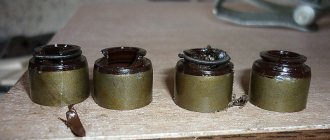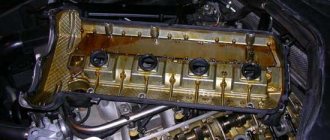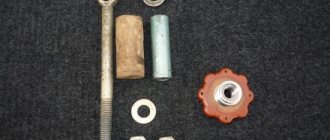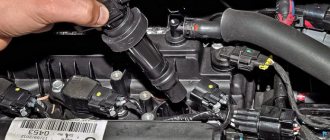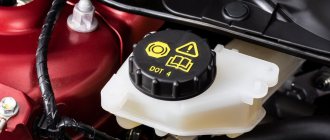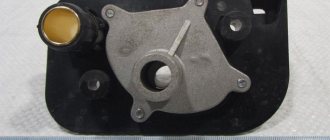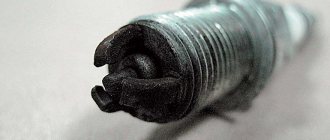Any problems in the car must be repaired immediately, otherwise a complication may follow and, as a result, complex and expensive repairs will be required (in most cases this is not an exaggeration, but a fact).
Some cars have a certain number of shortcomings that owners are prepared for when purchasing. For many motorists, oil in Priora spark plug wells has become a common occurrence, although the phenomenon does not occur so often. And therefore, owners of domestic cars are trying to solve this problem as soon as possible.
If you have the skills to restore a vehicle, you can carry out repairs yourself; no difficulties will arise during the execution.
Why does oil accumulate in the spark plug wells in Priora and what does this lead to?
The problem is common in 1.6 liter engines. In early versions, there were rubber gaskets under the valve cover, while the updated ones use exclusively sealant to tightly fit the parts.
For a modern Priora, oil in the spark plug wells is formed as a result of the sealant drying out after long-term use of the car or when using a low-quality composition. Therefore, completely removing accumulated oil and old sealant will be the right solution to the problem.
This is the same case when the plant tried to reduce costs and simplify the design. However, they did not take into account one simple rule: “Kroilovo leads to Popadalovo.” This principle can be applied to all cases in life, and in relation to your car as well.
Oil can accumulate in the Priora well even in a completely new car, therefore, immediately after purchase it is worth checking the vehicle at a service station or in your own garage. Otherwise, a brand new car can present a very unpleasant surprise, and the reason for such a dirty trick lies solely in the sealant used.
There is a high probability that after release or a long period of inactivity of the car in the cabin, the low-quality composition will simply dry out. And as a result of test or first long trips, oil will accumulate in the wells. And in order to avoid expensive repairs on the purchased model, you should not miss the opportunity, but check the quality of the installed system.
If the oil remains in the spark plug well for quite a long time, the rubber insulator of the spark plugs will soften as a result. This will lead to a very serious problem - puncture of spark plugs, insufficient supply of specialized oil to the engine.
Naturally, such a phenomenon will cause unstable operation of the power unit, as well as subsequent more frequent diagnostics and replacement of spark plugs. Therefore, for Priora, oil in spark plug wells is considered, although a common problem, but quite acute. And as a result, it requires immediate permission, otherwise untimely repairs may be necessary when the car simply stalls on a country road.
Communities › Chevrolet Club › Blog › Oil on spark plug threads
I apologize if anyone is tired of it, but still another symptom is carving candles in oil. And most importantly, the spark plugs on top are absolutely dry. But it doesn’t seem like 0.5 liters of oil per 200 km goes there. Where is it from? Well, here’s an example of over-gassing (if it’s water flying out)
Comments 37
There is no oil in your cylinders! There is oil in your spark plug wells. When unscrewing the spark plugs, it flows down the threads. Like this!
the same garbage, one spark plug is dry, the other three threads are in oil, the level is from replacement to replacement, I change the oil every 8 thousand, I checked the wells dry with a clean rag, there is no blue smoke
Eh. So think about it... either the Masor is being eaten and the caps are splashed there, or Shell oil is caught G
I pour Castrol oil, the hydraulics started to tap, the master advised me to pour Elf 10W40 when changing the timing belt because he says the engine is not new and the oil is supposedly good, mileage is 172 thousand
I want to try 5v40 zik or lukoil lux. Tomorrow I’ll go to a hundred. They'll measure the compression and tell you to check for leaks, and then I'll decide to change the oil or remove the head. On the forums they write that the oil on the threads of the spark plugs is the caps, but damn, 2.3 liters have already been added, there could be rings, but the electrodes of the spark plugs are fine. condition... a riddle
The corrugation that goes from the crankcase to the air filter is absolutely dry and without oil
Well, let’s say... how long are you going to keep adding? Miracles don’t happen, the rings need to be changed because the biggest waste is precisely because of them, it simply doesn’t have time for the suction, and in principle, not much gets through the corrugation, in six months I accumulate two or three tablespoons with a volume of 3.5 liters , which, according to his passport, is entitled to a consumption of 1 liter per 5000.
Of course, I’m not an expert, but if 2.4 liters of oil were consumed in the combustion chamber, then there would be traces of burnt oil on the spark plugs and at least some smoke would be coming out. So the day x has already arrived - today is a hundred, there were compression measurements and all sorts of examinations, and then it’s a decision to open it or not
smoke doesn’t always come out of the chimney, in fact, it’s not a necessary concomitant, it can easily be burned out along with gasoline, and only when the pistons are completely crushed will it start to move
A hundred people said that these are caps and the oil on the threads of the spark plugs is also caps. They explained the consumption on the highway by the fact that I constantly drive at 3k and the caps cannot cope. They just rode around with me. The compression was supposed to be measured, but I was driven in the heat and forgot to ask how much. But they also made me happy... my power steering reservoir is leaking and its drops are flying into the gearbox, and they didn’t understand whether my oil seal between the engine and the manual transmission was leaking or not. So a puddle forms on the left side, flowing down from a thing that looks like a mini protection. In general, you need a test drive.
What to do if oil has accumulated in the spark plug wells of the Priora?
Novice motorists are advised to contact a specialized service station for proper repairs. If the owner wants to save on repairs and carry out them himself, then he will need to study the instructions in detail and follow them exactly.
Since oil in spark plug wells is not only an unpleasant problem for Priora, but also a rather serious problem, it is necessary to begin solving it as early as possible.
Complete repairs are carried out according to the following scheme:
1. The intake manifold is removed.
2. The timing belt cover and the belt itself are removed.
3. The valve cover is removed.
4. The camshaft is removed and the old sealant is removed from all surfaces. Let us dwell on this point in more detail. The phrase “the old sealant is removed” does not mean that you can pick it off with a screwdriver or knife! Under no circumstances should you do this! There will be scratches and scratches on the metal, and you will never be able to achieve sealing of the parts.
They will snot oil and suck in air. The sealant can be removed with gasoline, acetone, and white spirit. Just wet the cloth and rub the surface until the part is clean.
5. The surface of the cover is coated with anaerobic sealant, and assembly is carried out in the reverse order.
Such a system is quite simple, but it also requires careful sealing of the joints between the well connections. Don’t forget about the wells themselves, because the elements quite often contain old composition on the walls. They are usually covered quite thoroughly with sealant and this should also be wiped off the surfaces.
All this will allow you to remove oil and sealant from the spark plug wells on the Priora and achieve optimal system condition and normal engine operation.
Old sealant must be washed off. If residues remain, they may interfere with the correct and high-quality sealing of the parts. As a result, the above operation will need to be repeated.
The cost of the work is minimal, since only one tube is enough to cover all surfaces. It is also important to consider that Priora oil accumulates in the well if it is not sealed correctly again, and as a result, you will need to lose personal time for another repair.
To process the connection of the wells, you need to use a special red sealant, which can be purchased at any automobile store or workshop. But when carrying out work, it is important to remember about the correct installation of the camshafts and all other parts.
Correct operation of the system will only be guaranteed if all removed elements are carefully assembled. If the work was carried out incorrectly, and more serious problems followed: breakdown, deterioration of the power unit, then it is recommended to contact a professional workshop to perform high-quality repairs.
For owners of models with a 1.5 liter engine, such a replacement is not suitable. Because you will need to purchase new gaskets and install them between the connecting parts. In particular, the cost of such repairs will be very insignificant. But it is worth remembering that the spark plug is pierced, and that the coil may simply fail later.
When making repairs, experts recommend using a heat-resistant sealant, as well as high-quality oil, which, in case of leakage, will corrode the insulation more slowly. It is also worth removing not only the old sealant, but also the deposits that have formed, because it also negatively affects the operation of the candles. The normal functioning of the car will be ensured only if its normal condition is maintained.
VAZ family cars have many features in terms of maintenance, and one of them is oil getting into the spark plug wells. The reasons for this phenomenon can be different, largely depending on the specific model and type of engine. Today we will look at the dangers of oil leaks in the spark plug wells of internal combustion engines and how to solve this problem with your own hands.
Choice
The choice of candles today is quite extensive. But we’ll talk about which ones are used for the VAZ 2110 and what can currently be considered the best choice for your car.
Candles differ from each other mainly in the material from which the electrodes are made.
| Candle type | Peculiarities |
| Copper | These are classic spark plugs for VAZ, installed by the factory. The operating life is up to 50 thousand kilometers. Some of them are coated with yttrium alloy to increase the reliability of the electrode. |
| Platinum | They are characterized by increased resistance to temperature fluctuations and corrosion, which has a positive effect on the service life of the elements. Such elements are capable of operating up to 90 thousand kilometers |
| Iridium | The characteristics are in many ways close to platinum candles; today they are considered the most durable and high-quality. Safety margin - about 90-100 thousand kilometers |
The service life may increase or decrease depending on the care, conditions of use of the vehicle, and the quality of the fuel being poured.
Platinum candle
Causes of failure and solutions to the problem
This kind of trouble happens quite often. Let's figure out why. Oil in spark plug wells appears due to wear of the gaskets. In general, this problem is not so dangerous, at least not as dangerous as, for example, the same lubricant getting on the cylinder head. Perhaps the most serious consequence of such a problem is the softening of the rubber insulator of high-voltage wires, which, in turn, will cause a breakdown. But this does not mean at all that you can let things take their course. Have you noticed that oil is getting into the spark plug well? Change the well gaskets immediately - and the problem will be solved. Otherwise, you will have to change the spark plugs very often (usually their service life is reduced several times).
Reasons for increased consumption
Several can be highlighted. The most common is wear of the valve stem seals. They are installed in the gas distribution mechanism.
Problems with caps should be solved very carefully, despite their simplicity. So, these elements are made of rubber - it can harden. This probability increases significantly if the engine does not warm up well. “Priors” with high mileage often suffer from this. The cuff (if it is frozen) will not be able to fit tightly into its seat - because of this, the oil will enter the valve sleeve without any obstacles. As a result, the lubricant will enter the cylinders, where it will burn safely. Oil can also get into the exhaust system. There will be characteristic blue smoke.
How to make repairs?
We have already found out why oil forms in spark plug wells, now let’s talk about how to replace the gaskets. First we need to prepare all the spare parts and materials. When performing leak repair work, you will need:
- Two valve cover gaskets.
- 10 sealing washers.
- Grease WD 40 and
- 4 spark plug well seals.
- Engine cleaner.
Having prepared everything you need, you can safely get to work. In general, the process of replacing well gaskets can be divided into several stages:
- Removing the valve cover.
- Dismantling of wells.
- Removing old O-rings and installing new ones.
- Reassembly.
How to determine if there is a problem
If you are not a seasoned car enthusiast and the phrases “troubling the engine” cause you slight bewilderment, the only possible way to check the performance of the spark plugs is to look. Upon visual inspection, a candle that has been in oil for a long time will have a characteristic soot (its end will be completely black).
If the candle has spent a little time in the “pool”, it will just have oil at the end. You need to know these characteristics, because the longer you use a car with flooded spark plug wells, the more likely you will be to stand in the middle of the road, wondering why the car doesn’t go further. You can also determine that there is oil in the spark plug well by increasing the engine starting time.
More detailed instructions
Below we will look in detail at how to eliminate oil in the spark plug wells of the 2112 VAZ and other car models of the Volzhsky Automobile Plant.
So where do you start? First, remove the plastic engine cover and receiver. All holes that are in the intake manifold are closed with covers (we need this in order to prevent foreign objects from entering the part). Next, the ignition module is dismantled, as well as the crankcase ventilation hose from the cylinder block cover pipe. Then, using a 10mm wrench, unscrew the bolt of the injector wiring harness connector bracket. Using a size 8 spanner, unscrew the 15 mounting screws on the cylinder block cover (also called the valve cover). After this, the block cover itself is removed from the machine.
Checking the hydraulic pusher
Next, you need to check the hydraulic pusher. How to do it? Everything is very simple - using a soft metal drift (or a simple screwdriver), just press on it and monitor its further condition. Ideally, the hydraulic pusher should be pressed with great force.
But if you used a minimum of force to do this, then most likely this device needs to be replaced. By the way, when diagnosing a hydraulic tappet, the camshaft cam must be directed towards the first with its back side.
How to replace this part?
Since we cannot neglect replacing the hydraulic pusher when solving our problem, we will devote a few words to replacing this device.
The first step is to remove the camshaft and the wire from the oil pressure lamp sensor. Next, use a 8mm spanner to unscrew the 20 mounting bolts of the bearing housing for this shaft.
The bolt connecting the rod to the rear engine mount bracket must also be removed. Next, at the same place, remove 3 nuts using a 15mm wrench. After this, the rear support bracket will not be securely fastened and can be safely removed (as well as the camshaft bearing housing). The guide pipes of the spark plugs are removed from the latter. Next, the camshafts are removed from the housing. Don't forget about the seals.
At the next stage, the 2 rear plugs of the cylinder block and the camshaft bearing housings are dismantled. To remove the hydraulic pusher, a magnet is applied to its end part, and the part is successfully removed from the head socket.
Before assembly, the cylinder head is thoroughly cleaned of dirt, and the camshaft bearing housing is thoroughly cleaned of oil and old sealants. Next, the shaft cams and bearing journals are lubricated with new engine oil.
On the surface that interfaces with the cylinder head, a special substance (sealant) “Loctite No. 574” is applied with a 2-mm flagellum. Next, the housing is installed back into place.
Now you need to lubricate the O-rings and install the guide pipes into the holes of the cylinder head and bearing housing. After this, new ones are pressed in and plugs are installed on the back of the block.
Before installing the cylinder head cover, it is necessary to apply a sealant to its surface (the same Loctite that eliminates oil in spark plug wells). Priora VAZ, however, can be repaired in another way. How exactly - read further in the article.
How to fix the problem?
To ensure normal operation of the motor, there are several options to avoid the problem. Let's look at each of them.
Cleaning the crankcase ventilation system
The procedure is demonstrated using the example of a Lada Granta car:
- It is necessary to loosen the clamp and disconnect the crankcase ventilation system pipe from the air supply line. Disconnect the second end of the pipe from the fitting located on the cylinder head cover; the hose can then be removed. Carry out the dismantling of the small branch pipe in the same way; to do this, you need to disconnect it from the cylinder head and the fitting of the injection module. At this stage, you need to disconnect the supply pipe of the ventilation system, disconnecting it from the BC and cylinder head fittings.
- All pipes must be washed with kerosene or fuel, then blown with air and dried. It would be a good idea to clean the fitting holes.
- Remove the cylinder head cover.
- Unscrew the screws securing the oil separator device on the inside of the cylinder head cover and remove the washers. The oil separator housing must be removed.
- Then all the screens are removed from the cylinder head and must be washed with kerosene along with the cylinder head cover and the oil separating element.
- All system components are assembled in reverse order.
Engine decarbonization
For candles that are filled with oil, there are not many options for solving the problem. You can try to decarbonize the power unit, which is done as follows:
- High-voltage cables are dismantled and all protective equipment is removed. At this stage, it is advisable to remember their location. After this, unscrew the high-voltage cables from the reels.
- The consumables are drained from the motor and the drain plug is put in place. A special decarbonizing agent must be poured into the engine. The best option would be to decarbonize all cylinders of the internal combustion engine.
- After this, the SZ must be slightly tightened, this will prevent the evaporation of the product. So the car should be left for 6-12 hours, depending on what is written in the instructions for use of the cleaner. After waiting the appropriate time, unscrew the lock, but do it carefully, otherwise the cleaner, along with carbon residues, may splash throughout the engine compartment.
- Afterwards, the drain plug is unscrewed and all consumables are drained along with the remaining carbon deposits. You can pour oil into the engine and spin it on the starter for 10 seconds; this must be done without installed SZ and a connected coil. Such actions will prevent water hammer when starting the internal combustion engine. When you are sure that there is no more carbon deposits in the cylinders, the SZ must be screwed into place.
How to make a puller?
Everything is very simple and cheap. To assemble this tool, you need to have a metal pin at least 15 centimeters long, a piece of rubber hose with a diameter of 20-25 millimeters, several washers, nuts and one bushing. What to do with all this? First, a washer is put on a long pin, then an elastic band, a bushing and nuts. That's it - the spark plug well sealing ring remover has been successfully completed! The cost of such a tool is no more than 100 rubles, and it can be made in almost a few minutes. This way you will very quickly remove oil from the spark plug wells. Priora and many other models of domestic cars are repaired using this tool.
Make sure that the elastic is clamped on both sides with washers. In this case, the diameter of the latter should be as close as possible to the width of the spark plug well itself. Otherwise, the clamped rubber will crawl out into the gap between the well and the washer, and we don’t need this.
The pull handle is made of a valve nut. The lower washer should rest against the tip of the stud, and the upper one should be pressed by the bushing.
So, let's start the renovation. First, the puller is inserted into the spark plug well, after which the lower nut is tightened until the axial movement of the tool allows us to pull out the well. After a little effort, the glass will be successfully removed.
During the work, make sure that the rubber part of the inserted puller does not protrude beyond the well. Similar to the first case, we install new oil seals, lubricate them with oil and assemble them in reverse order. By the way, the installation process will take you less time than dismantling.
Nuances when performing work
If you decide to resort to the second option, do not forget about the rules of operation and work with this puller, otherwise you will not be able to remove oil from the spark plug wells. What exactly are we talking about? Let's explain.
Firstly, the rubber band of the tool must be fully immersed in the spark plug well. Otherwise, it will gradually expand, and you will not be able to remove the glass.
Secondly, when removing the well, there is a possibility that the valve covers will move, which can subsequently block the key exit. But since the thickness of the glass wall is too small, the mentioned part can be easily removed using a long thin screwdriver.
Thirdly, when pulling out the spark plug wrench, you need to make sure that the old lower oil seal does not jump out of place.
Let's sum it up
In the first case, we spent about 4 hours and about one and a half thousand rubles to complete all the necessary work. Using the second method, you will spend no more than 1.5 hours on repairs, since the need to remove and reinstall the receiver and valve covers will be eliminated.
So, we found out why oil forms in spark plug wells and how to fix this problem with your own hands. Don't break!
It is necessary to understand the reason why the oil turned out to be in the spark plug well of the VAZ 2110 after the main thing has been clarified. The reason for this factor may vary, and it also depends to some extent on the types of engines. On a VAZ 2110, oil in spark plug wells can lead to unpleasant consequences.
Consequences of oil
What could be the consequences if you do not pay attention to this in time? When operating a car with such a defect, breakdown of high-voltage wires occurs due to softening of the rubber insulator. Also, premature carbon deposits will occur on the candles, so they will not reach their service life. This leads to their frequent replacement.
Engine designs for the VAZ-2110 are constantly being improved. Therefore, on some engines, such as 1.5 liters, guide pipes - cups - are installed. Engines with a volume of 1.6 liters are not equipped with cups; the design includes spark plug wells. You can determine this yourself:
- Unscrew the spark plug.
- Visually inspect the nest.
- If glasses are installed, then the surface is smooth up to the top of the well.
- If it is absent, two slots are visible in the well.
Engine 1.6 l
The design of 1.6 liter engines is a more modified version. On such engines, the appearance of oil in the well may be due to a poor seal. You can try to stretch it first; the nuts on the head studs may be loosened:
- To do this job you will need a #8 socket.
- Tightening must be done by alternating the nuts on the right and left sides.
Wipe the seats of all candles with a rag. Try the car in operation. Oil continues to flow into the spark plug sockets, which means it is necessary to replace the layer of sealant on the lid seal. To do this, you need to buy an anaerobic sealant from a car store:
- Park the car in the garage.
- Disconnect the negative terminal from the battery.
Prepare the tool:
- head No. 8;
- open-end wrench No. 10, No. 13;
- a screwdriver with two attachments – flat and Phillips;
- sharp knife.
The procedure for tightening work:
- Press out the plastic fastener.
- Disconnect the wiring harness connectors from the coil output.
- Unscrew the bolt that secures the coil to the cylinder head cover.
- Remove the coil from the spark plug well.
- Using the same method, disconnect the injector wire harnesses from the front bracket. Using an open-end wrench No. 10, unscrew the bolts of the front and rear brackets.
- Loosen the screws on the clamps of the crankcase ventilation exhaust hoses, from the pipes of the cover and the cylinder block.
- Take them off.
The oil level indicator (dipstick) is installed on the guide bracket, so you need to unscrew the screw that secures it.
- Remove the guide assembly with the pointer.
The intake manifold is attached to the cover with two nuts; unscrew them with a #10 open-end wrench. The manifold is attached to the block head with three No. 13 nuts and two bolts; unscrew them with an open-end wrench:
- Then remove the manifold.
- Using socket No. 8, unscrew the nuts from the cover studs.
Using a flat-head screwdriver, carefully press the cover away from the block, holding it with your hand by the protrusions around the perimeter:
- Take it off.
- Place it on the workbench.
From the inside, use a flat screwdriver to carefully remove old sealant. Moisten a rag in solvent to degrease the areas where the sealant is applied. Wipe the inner surface of the lid with a rag. Clean the surface of the block from applied old sealant and degrease it with a solvent.
Note: do not degrease with gasoline, as it contains oil additives.
After completing the cleaning work, apply a thin layer of sealant along the edge of the block:
- Place the lid.
The nuts must be screwed in the order established by the assembly technology.
1.5 l engine
Oil in the spark plug well can accumulate due to damage to the oil seals (seals) that are installed in the wells themselves. In each well, oil seals are installed at the top and bottom of the glass (2 pcs.). It is necessary to buy oil seals after inspecting them. You need to make sure that there are no cuts, cracks, or growths on them. The rubber seal should have a glossy shine.
Summary
The reasons for oil leakage into the spark plug wells of the sixteen-valve Lada Granta power plant is a loose connection of the valve cover to the camshaft bed and/or the camshaft cover to the cylinder head. A malfunction increases the level of fire danger and leads to failure of the ignition coil and spark plug.
Treating the joints of the mating parts of the cylinder head with an anaerobic sealant helps prevent leakage. To apply the sealing compound, it is necessary to dismantle the parts and prepare the surfaces. When reassembling, be sure to replace the receiver gaskets and use a torque wrench.
Hi all!
Everyone knows very well the disease of VAZ 16 valve engines, when oil accumulates in the spark plug wells. My engine was no exception. Since the purchase (5 years ago), the oil has accumulated, but it was not enough to repair immediately. This week I decided to look into the 4th well to find out the oil level (it’s there anyway, I haven’t looked since the summer). To my surprise, there was half a candle there! Accordingly, it was necessary to immediately take repair measures, otherwise it would risk breaking the spark plug (at best) or the ignition coil (at worst).
Where and why is oil collected in spark plug wells:
1. Oil flows in 2 planes - from the valve cover and the camshaft pastel. 2. A sealant-gasket is applied between these planes (from the factory the sealant looks like some kind of spraying) and, naturally, over time the sealant loses its properties and we observe a leak. 3. 90% of the leak is observed in the 4th cylinder. Because it heats up the most. And in winter, the engine operates with a high amplitude of temperature changes.
Solution to the problem:
1. We go to the service center. 2. We buy sealant, gaskets... 3. They will dismantle for you: throttle body, intake manifold, valve cover, shaft gears, timing belt, camshaft pastel, shafts. 4. Sealed and put back together. 5. Repair price 3,500 rubles + spare parts + queue + personal time. It’s not a fact that they will give you a guarantee for repairs; they may say that you bought a bad sealant! And then you will again be left alone with your problem.
Solution to the problem (my case):
1. I was leaking oil from the valve cover, this was observed not only in the wells, but also on the intake/exhaust side. Accordingly, the lid must be 100% sealed. Everything was dry from the camshaft pastel, so I didn’t dismantle it, and I really didn’t want to remove the shafts! The bolts are fragile and can break your head, but din. I don’t have a key, and the service center where you will be repairing it is unlikely to have one! But I secured myself in a different way; I’ll write about it below.
2. To get to the valve cover, he removes everything that we can see (there is a lot of information on the Internet). There is a small problem when removing the intake manifold. This is if you have an ICE-124 with power steering, if there is no amplifier, then in general everything can be easily removed. The leftmost intake mounting bolt is not located in a very convenient place. To do this, you need to move the generator away from the block and take a ratchet with a “cardan” attachment and unscrew it. After my previous car Oka, I don’t see any problems at all! You can crawl anywhere!
3. Remove the cover and wipe off the old sealant with a solvent. I also vacuumed the spark plug wells and the engine to ensure there was no debris.
Replacing oil seals
To replace the seals, it is necessary to remove the valve cover; the work on removing it is described above. The process of removing the wells must be carried out using two flat-head screwdrivers. At the top of the wells there is a protrusion into which screwdrivers rest on two opposite sides:
- Carefully press the screwdrivers with equal force at the same time and remove the glasses.
Warning: carefully remove the cups, do not allow the lower sealing ring to fall into the camshaft bearing housing.
Clean traces of sealant from the dismantled glasses, wipe with a rag the places of accumulated dirt around the circumference of the wells:
- Install the purchased oil seals inside the wells and lubricate them with engine oil.
- The installation of the well must be carried out with care.
The well is fixed with a collar, which, by design, is located at the upper ring of the bearing cover. Therefore, further work on its installation must be carried out using head No. 22:
- Place it along the edges of the well and press until it clicks.
- This will mean that the well is latched with a collar.
Oil seals in wells can be replaced without removing the valve covers. To do this, you need to make a puller with your own hands. Materials for its manufacture:
- hairpin 14 cm long;
- rubber hose with a diameter of 25 mm;
- two metal washers with the outer diameter of the spark plug well;
- sleeve;
- nuts in the amount of 3 pieces.
Put on the hairpin in the following order:
- puck,
- rubber hose,
- puck,
- bushing,
- nuts
The lower washer places emphasis on the tip of the stud, the upper washer is clamped with a sleeve:
- insert the manufactured puller into the well,
- tighten with the lower nut until the well can be removed with axial movement.
- apply a little force and the glass is removed.
Attention: the applied friction force allows you to remove the puller with the clamped spark plug well. Warning: it is necessary to take into account that the rubber strip of the puller inserted into the glass should not look beyond the edges of the spark plug well!
The same principle applies to installing new oil seals along with the cups:
- Before installation, they must be lubricated with engine oil.
Note: the elastic band of the puller should not protrude beyond the edges of the well, otherwise the screwed nut will crush its edges, which will not give the required effect.
Be careful when removing the spark plug well, do not allow the old lower oil seal to come off. Carrying out the work yourself will allow you to save financial resources in the amount of 1,500 rubles. This is the starting price for similar repairs in auto repair shops.
- The cost of oil seals is 100 rubles. for one set.
- The price of anaerobic sealant is about 700 rubles.
Repairs to remove the causes that lead to the appearance of oil in the spark plug well on a VAZ-2110 can begin after watching the video and carefully studying the photos, which indicate all the locations of the repair work. It is also necessary to familiarize yourself with the instructions for applying the necessary precautions.
Most likely, most drivers - both experienced and newbies - hardly think about the dangers of oil getting into spark plug wells. And completely in vain. The reasons for this phenomenon can be various factors. In many ways they depend on both the engine model and its type.
In any case, a prudent owner will most likely prefer not to rush headlong to the nearest service station, but to try to solve the problem on his own. So let's take a closer look at this.
What are the dangers of oil getting into spark plug wells?
A similar nuisance can happen quite often, especially on domestically produced cars with decent mileage. Let's look at how to solve the problem using the example of the Lada Priora, a domestically produced VAZ car, not without some shortcomings.
Possible consequences?
The main reason for the appearance of oil in spark plug wells is wear of the gaskets. What could be its consequences for the health of your car? In fact, to be honest, such a flaw in operation cannot lead to anything particularly military, according to experienced repairers. That is, you can travel with such a problem, but not for too long. This is not the same specified lubricant getting on the cylinder head (cylinder head).
One of the possible consequences is when the rubber insulator of wires (high voltage) softens, which can also cause a breakdown of the electrical circuit. However, the fact that the breakdown is insignificant should not mean that it is left to chance (many people like to drive until everything closes and begins to fall off). And if you notice that there is grease in the spark plug well, the gaskets of this unit need to be changed as quickly as possible. This way the problem will be eliminated and the issue will be resolved.
Also noticed by masters
, that in this situation it is necessary to change the candles themselves quite often. Their resource is significantly reduced (several times, according to experience). And if you don’t want to unscrew and install new ones with enviable consistency, then you definitely need to do the appropriate repair work.
Repair
How to handle the change of these parts correctly? First, for a successful procedure, you need to prepare the appropriate parts and tools. We will need: a pair of valve cover gaskets, 10 seals, engine cleaner, 4 oil seals for wells. Having collected the above, you can begin. It is better to carry out the process in a closed, heated and illuminated room, or, as a last resort, in a place protected from wind and dust (because dust can get into unprotected areas of the unit, creating additional problems).
We carry out the work in several stages:
- Remove the valve cover and also the receiver. We close all possible holes in the collector so that unnecessary parts, objects and dust do not get into the assembly itself;
- We dismount the ignition and hose;
- Unscrew the bracket bolt on the injector (key 10). Then – the screws on the block cover (15 pieces). Remove the cover;
- Next, you can check the hydraulic pusher. This is done quite simply: using a screwdriver. You need to press (it should press with good force). Otherwise, the mechanism is changed. When performing such diagnostics yourself, carefully ensure that the camshaft cam is directed with the back side;
- Afterwards it is necessary to dismantle the spark plug wells. This procedure is done using an appropriate puller. It must be inserted into the spark plug well, the nut is tightened and the mechanism is quite easily dismantled;
- Next, remove the old O-rings and install new ones in their place;
- We put everything back together in reverse order. Remember that before assembly, the head must be thoroughly cleaned of dirt and the bearing housing must be thoroughly cleaned of old sealant and oil. The shaft cams must be lubricated with fresh lubricant. Before installing the housing, we apply sealant to the places where it was before dismantling.
Grease accumulation in spark plug wells is a common problem on Priora cars. The reasons for this may vary. They largely depend on the car model and the design of its engine.
Any problems that arise in the car must be corrected immediately, otherwise a complication may arise, and then more expensive repairs will be required. So if you notice oil in the wells on your Priora car with 16 valves, then this situation cannot be ignored.
The problem of lubricant accumulation in spark plug wells is especially common in engines with a volume of 1.6 liters. In older versions, rubber gaskets were located under the valve cover. New versions use only sealant to ensure good contact between the parts.
In a modern Priora car, oil appears in the spark plug wells due to the sealant drying out after using the car for a long time or when using a low-quality compound. So simply removing the grease and used sealant will not fix the problem.
This is exactly the case when the manufacturer decided to simplify the design in order to reduce costs. But this resulted in new problems for car owners.
In Priora, oil can collect in wells even in a completely new car. So, immediately after purchasing a new car, it would be a good idea to check it at a service station or at least yourself. Otherwise, your new car may cause you troubles, the cause of which will be hidden in the used sealant.
There is a big risk that due to the long period of idle time of the car in the cabin, the low-quality composition will simply dry out. So, after the first trips, oil will begin to accumulate in the wells, which may subsequently lead to the need for expensive repairs.
Due to the prolonged presence of oil in the spark plug well, the spark plug insulator will begin to soften. This can result in a huge problem - puncture of spark plugs, poor supply of lubricant to the engine.
As a result of this phenomenon, the power unit will begin to operate unstably, in addition, the spark plugs will have to be replaced much more often. Therefore, the presence of lubricant in the Priora spark plug wells is a very acute problem that requires an immediate solution.
For what reasons does soot appear on candles?
Now it is possible to use many methods when diagnosing a car and its engine. The most common are:
However, one of the ways that can accurately indicate the occurrence of malfunctions in the engine is the appearance of carbon deposits on the spark plugs, the cause of which lies in the engine.
What does the appearance of carbon deposits on candles indicate?
By examining the appearance of the removed spark plugs, a specialist can easily determine the current condition of the main power units, as well as malfunctions in the operation of the vehicle’s auxiliary components and systems.
Depending on the color and degree of carbon deposits observed on the spark plug, auto mechanics accurately determine the diagnosis of the engine. At the same time, an understanding is formed - the engine operates primarily on a rich or lean fuel mixture. Also, a different color shade of soot on a set of spark plugs indicates specific reasons for poor engine performance.
The main malfunctions include:
Advice: in order to see the reason for poor engine performance, you don’t always need to go to a car service center. First, remove the set of spark plugs from the cylinder block and look at the color of the carbon deposits that appear. The indicator symbols on the instrument panel will also indicate problems with the engine.
What does the color of soot deposits indicate?
Using a color shade, you can quickly understand what problem areas are in the engine of your car. However, simply replacing samples will not solve the cause of soot - new spark plugs will very quickly become unusable. Currently, there are 3 main colors of deposits in the ignition system.
Each of the colors presented indicates the occurrence of a specific malfunction or group of problems in the car’s engine.
The appearance of black soot
This plaque can be either dry or oily. The appearance of a black coating in dry form indicates that an enriched mixture is being supplied to the engine. Candles become covered with such soot as a result of:
This is interesting: Step-by-step instructions on how to reset service intervals for cars yourself
If black oily deposits appear, it is necessary to check the possibility of oil getting into the combustible fuel mixture itself. As a rule, oil leaks as a result of wear of the oil scraper type piston ring set. In addition, the cause of oil deposits can be damage to the valve system caps.
Advice: if you have recently repaired a VAZ-2114 generator, be sure to check the spark plugs. Perhaps some of the problems with the car lie there.
What to do if grease appears in the Priora wells?
For beginners, it’s better to go to a service station and order repairs. If the car owner has sufficient experience and does not want to spend his own money, then he can carry out the repairs himself.
Repair instructions
- First you need to remove the motor cover and receiver. All holes in the intake manifold must be covered. This is required to prevent foreign components from entering the part.
- After this, you can begin dismantling the ignition module and the crankcase ventilation hose from the cylinder block cover pipe.
- Then, using a 10mm wrench, you will need to unscrew the bolt of the injector wiring harness connector bracket.
- Using a size 8 wrench you will need to unscrew the 15 screws on the cylinder block cover. After this, you can remove the block cover itself.
Checking the hydraulic pusher
After the work described above has been carried out, you will need to check the hydraulic pusher. This is easy to do using a metal drift or an ordinary screwdriver. You just need to press the hydraulic pusher and check its condition. It must be pressed with great effort.
If you hardly had to apply any force, then this device requires replacement. Make sure that when checking the hydraulic tappet, the camshaft cam is turned to the back of the device.
Replacing the hydraulic pusher
- First you will need to remove the wire from the oil pressure lamp sensor and the timing pulleys. After this, you will need to unscrew 20 bolts of the bearing housing using a 8-mm spanner.
- You will also need to remove the bolt that connects the rod to the rear engine mount bracket. At the same place you will need to remove three nuts with a 15 wrench. After this, you can easily remove the bracket and camshaft bearing housing. Then remove the spark plug guide tubes. After this, you can remove the oil seals and camshafts.
- In the future, it will be necessary to dismantle the two cylinder block plugs located at the rear, along with the camshaft bearing housing. It is not difficult to remove the hydraulic pusher; to do this, you just need to bring a magnet to it.
- Before assembling the cylinder head, it is necessary to clean it from dirt, and the camshaft bearing housing from used sealants and lubricants. After this, it will be possible to lubricate the bearing journals and shaft cams with new grease.
- You will need to apply sealant to the bearing housing connected to the cylinder head with a flagellum. After this, the housing can be mounted in its original place.
- Then you will need to lubricate the seal rings and install the guide pipes into the bearing housing and cylinder head, and then press in new oil seals. On the other side of the block you will need to install plugs.
- Before installing the cylinder head cover, sealant must be applied to it.
Cleaning
If the spark plugs are dirty, then it is not at all necessary to immediately replace them with new elements of the ignition system, igniting the fuel mixture in the combustion chamber of the VAZ 2110. Regular cleaning will quickly remove the dirt and return the spark plugs to their previous functionality.
There are several common cleaning methods that can be used at service stations and in garages with your own hands.
Regardless of the chosen method, we recommend that you follow the general principles of operation when cleaning the elements of the ignition system.
- Protect the coating of the spark plugs from abrasion; do not use rough sandpaper or other similar abrasives.
- Do not expose the candle to high temperatures. It is not worth heating them over a fire for the purpose of cleaning. Some people do this for some reason.
- Check the spark plug for resistance using a megometer. If the second scale does not show + infinity, then the spark plug will have to be changed. Cleaning is useless. With a value of 1000 it is also better not to try to resuscitate the element.
Now let's talk directly about cleaning methods.
Cleaning before and after
The formation of carbon deposits and flooding will require not only removing and drying the spark plugs, but also thoroughly cleaning them.
- One popular method is to remove carbon deposits with a fine-bristled wire brush;
- Another option is treatment with kerosene, which removes carbon deposits quite effectively;
- Another method involves the use of sandblasting. The effectiveness of this approach is short-term, so you will soon have to remove the candles again and clean them;
- Many people have also gotten used to using chemical converters. To do this, candles are placed in a solution, allowed to sit for about an hour, after which they are cleaned with matches, toothpicks to remove carbon deposits, washed with water and dried;
- In order not to buy specialized products, you can use acetone using the same cleaning principle;
- Our grandfathers cleaned candles with vinegar. To do this, you will need to dip them in vinegar for an hour, then add literally 5 drops of electrolyte;
- There is an ultrasonic cleaning method, but this requires specialized equipment.
Article on the topic: Ignition relay VAZ 2109
If you do not get the desired result, you will have to change the candles. But first they need to be selected.
An alternative solution to the problem
Repairs can be carried out without removing the valve covers and receiver. But for this you will need a special tool, which is not so often found in stores. Therefore, motorists have to make it themselves.
We are talking about a puller. To create this tool, you need a metal pin with a length of 15 cm, a hose with a diameter of 20-25 mm, nuts, washers and a bushing. You will need to put a washer on the stud, and then an elastic band and a sleeve with nuts. That's it, the tool is ready. Its cost will be 100 rubles. And it will only take a few minutes to create it.
The puller will need to be inserted into the spark plug well. After this, you will need to tighten the bottom nut so that we can easily remove the well. When performing work, make sure that the rubber part of the puller is not higher than the well. As in the first case, you will need to install new oil seals, lubricate them with grease and put them back together.
Experts advise using high-quality lubricant and heat-resistant sealant. Along with the old sealant, it is also recommended to remove carbon deposits; they are also harmful to candles. In order for the car to function normally, it is necessary to maintain all its components in good condition.
The second option requires much less time for repairs than the first. It is also simpler to implement and does not require financial costs.
Should I change the oil if the consumption is high?
Often, car owners, after identifying increased consumption, ask themselves the same question - do they need to change the oil completely every time or is it enough to add fluid from time to time as consumption occurs? Some motorists believe that it makes no sense to perform a complete oil change in this case. During the period, the same amount of lubricant will pass through the engine as if a replacement were being performed.
A complete replacement, in fact, must be carried out in accordance with technical service books and documents. The main function of oil is to reduce friction between rubbing parts and clean the engine. Debris settles in the pan or in the oil filter. But dirt is not removed from the engine. During operation, the amount of carbon deposits will increase, and constantly adding new oil will only compensate for the amount of dirty oil.
Such a liquid will always have a dark color. Therefore, it needs to be changed every 10 thousand, and together with the filter. Otherwise there is a risk of coking.
